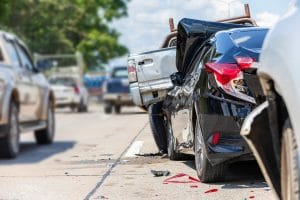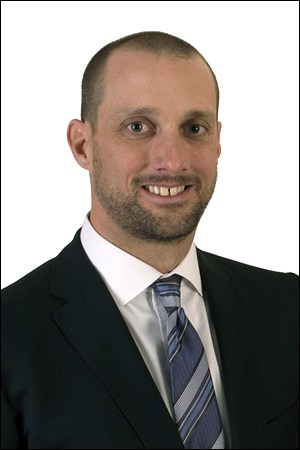Who Is at Fault for a Chain Reaction Car Accident?
 Sometimes rear-end collisions occur where multiple vehicles are involved, causing a chain reaction. A common example is when three vehicles (A, B, and C) are stopped at a traffic light. The driver of Car D (who normally is speeding or is distracted) then slams into Car C. Car C then strikes Car B. Car B then crashes into Car A. At first blush, it may be simple to just place all the blame on the driver of Car D. After all, if the driver of Car D had been paying attention, then none of the other vehicles would have struck each other.
Sometimes rear-end collisions occur where multiple vehicles are involved, causing a chain reaction. A common example is when three vehicles (A, B, and C) are stopped at a traffic light. The driver of Car D (who normally is speeding or is distracted) then slams into Car C. Car C then strikes Car B. Car B then crashes into Car A. At first blush, it may be simple to just place all the blame on the driver of Car D. After all, if the driver of Car D had been paying attention, then none of the other vehicles would have struck each other.
Except that isn’t always the fully story. There are many reasons why that simple analysis may not apply:
- Car C or car B may have been too close to the cars in front of them, even though they were all stopped.
- Cars C, B, or A all may have been moving slowly instead of being fully stopped.
- A driver of one of the vehicles may have had time and room to move to the side of the ride instead of striking the next vehicle in line.
- Car C, B, or A may sideswipe car E in another lane, adding another car to the mix.
- A driver in front of Car B may have backed up, causing or contributing to the accident.
As you can see, there are many different variables that can lead to a chain reaction car crash, and this is merely a small sampling of them. That is why if you are injured in a multi-car wreck like this, you want an Oklahoma City injury attorney to help you prove that you are not at fault, so you can be justly compensated for your injuries and your losses.
Contributory negligence in chain reaction cases
Oklahoma has a comparative negligence law which provides that you can recover personal injury or wrongful death damages even if you or a loved one who was killed was partially responsible for the chain reaction – unless you or the loved one was more responsible than the combined contributory negligence of everyone else involved.
If you were partially at fault for a chain reaction collision – for example, Car D was texting while driving but you (in Car C) were speeding – then both you and the driver of Car D are partially responsible for the accident. A jury might also find that you were partially at fault if you failed to leave enough room between your car and the car in front of you. To some extent, the possibility of a rear-end collision shouldn’t be a complete surprise. Drivers should stop so they’re not on top of the car in front of them.
If a jury determines that you were 20% responsible and the driver of Car D was 80% responsible, then your damage award will be reduced by 20%.
For example, let’s say you suffered whiplash due to the accident. Your medical bills, lost income, and your pain and suffering might make your case worth $100,000. Your damage award against the driver of Car D would then be reduced by 20%, which means your award will be $80,000 instead of $100,000.
The complexities of rear-end collisions involving more than two vehicles
The first difference between two-car collisions and multiple vehicle collisions is that there are many plaintiffs and defendants. In the four-vehicle crash that we discussed, all the drivers except Car D may file a lawsuit to recover damages. So could any passengers in any of the vehicles, including in Car D. The defendants may include the owners of the vehicles and the drivers. If the victims, drivers, and owners all reside in different states, that scenario further complicates how the cases are handled.
Another major concern is how the insurance is handled. Some of the questions that need to be resolved are:
- Which insurance companies are responsible for which claims?
- What happens if there isn’t enough insurance coverage to pay all the claims?
- What happens if one of the drivers didn’t have any insurance?
- What happens if your health insurance provider wants to put a lien on any awards?
- Whose insurance pays if the original cause of the crash was a defective part, or defective roadway, and not negligence?
The possibilities and complications can be overwhelming.
Proving how the multi-vehicle accident occurred
Chain reaction accidents require experienced Oklahoma City car accident lawyers. We work aggressively to determine exactly what happened and why. We determine fault by:
- Analyzing the damage to the vehicles. The location and extent of the damage can help assess fault.
- Having an investigator go to the accident site. Skid marks, the layout of the road, the position of the traffic light, weather conditions, and other factors can help determine how the accident happened.
- Conducting discovery. We ask oral and written questions of all the parties to the multi-vehicle accident. In addition, we depose (ask oral questions) of any passengers or witnesses who may have seen the accident.
- Reviewing the police report. It’s almost a certainty that the police will investigate the accident site and prepare a written report. We review that report for inconsistencies, and to see if the police have assigned fault in the crash.
- Working with traffic reconstruction experts. In some cases, where fault can’t otherwise be determined, we work with engineers, computer graphics professionals, and others who can help analyze and show how the chain reaction collision occurred.
At Cunningham & Mears, our Oklahoma City car accident lawyers handle the tough cases. For 20 years, we’ve been fighting for drivers, passengers, and bystanders. In most cases, we are able to negotiate strong settlements for your economic and non-economic losses. When insurance companies are unreasonable, we’re ready to try your case in court. For help with any rear-end crash or any vehicle accident, call our seasoned Oklahoma City lawyers at 405.232.1212 or use our contact form to schedule an appointment.

Ryan Y. Cunningham is a founding partner of Cunningham & Mears. Mr. Cunningham devotes his practice to protecting the rights of injured Oklahoma residents. In addition to assisting injured clients, Mr. Cunningham endeavors to improve personal injury representation by speaking on issues related to personal injury law to attorneys in continuing legal education courses and to law students. Learn More
